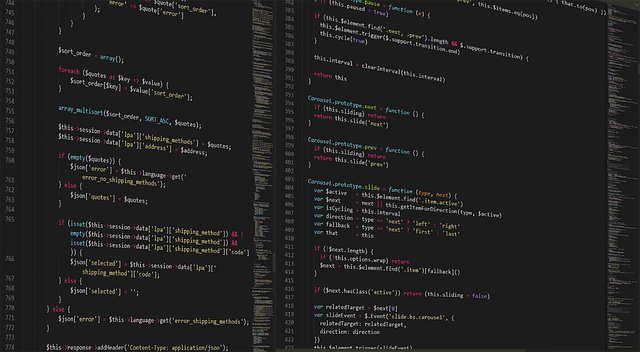Website development transforms static web pages into dynamic, interactive experiences using technologies like HTML, CSS, JavaScript, Python, Ruby, PHP, React, Angular, Vue, MySQL, PostgreSQL, MongoDB, AWS, Azure, Google Cloud, Docker, AI, and machine learning. Key aspects include choosing suitable frameworks/libraries, seamless database integration, robust server-side programming, efficient deployment strategies, strong security measures, and staying current with trends like progressive web apps (PWAs). These practices empower developers to build scalable, high-performing web applications tailored to diverse user needs in today's digital era.
“Unleash the power of the web with a deep dive into Web Application Development, a comprehensive guide designed to transform your digital vision into reality. From understanding core components like HTML, CSS, and JavaScript to exploring powerful frameworks and efficient database integration, this article covers it all. Discover the secret ingredients for optimal performance, explore diverse server-side languages, and stay ahead with the latest deployment techniques. Additionally, uncover crucial security considerations and glimpse into the future of website development. Get ready to revolutionize your online presence.”
Understanding Web Application Development: A Comprehensive Overview

Web Application Development is a dynamic process that involves creating interactive and data-driven websites. It goes beyond static HTML, CSS, and JavaScript pages by incorporating server-side programming languages like Python, Ruby, or PHP, along with databases to store and manage content. The front-end, which users interact with, is designed using modern frameworks like React, Angular, or Vue, ensuring a responsive and engaging user experience.
Understanding Website Development involves grasping how these components work together. Back-end developers build the server infrastructure, process data, and ensure secure communication between the server and client. Front-end developers focus on visual elements, user interfaces, and responsiveness across various devices. Integration testing and continuous deployment are crucial practices to guarantee a seamless and up-to-date application.
The Core Components of a Web App: HTML, CSS, JavaScript

The foundation of any web application is laid using three core technologies: HTML, CSS, and JavaScript. These languages are the building blocks for creating dynamic and interactive websites. HTML (Hypertext Markup Language) structures the content on a webpage, defining elements like headings, paragraphs, images, and links. It provides the framework that gives meaning to a website’s content.
CSS (Cascading Style Sheets), on the other hand, is responsible for the visual presentation of these elements. It allows developers to style and format the HTML, controlling the layout, colors, fonts, and overall design aesthetics. CSS ensures that websites are visually appealing and consistent across different devices and browsers. JavaScript, the third component, brings interactivity and dynamism to web pages. It enables the creation of responsive user interfaces, handling form validations, animations, data manipulation, and even complex functionalities like real-time updates. Together, these technologies empower website development, making it possible to build modern, feature-rich web applications that cater to diverse user needs.
Choosing the Right Frameworks and Libraries for Efficient Development

Choosing the right frameworks and libraries is a pivotal step in efficient web application development. They serve as building blocks, offering pre-written code that accelerates development time and reduces complexity. For developers, this means faster prototyping, easier maintenance, and more time to focus on innovation rather than repetitive coding tasks. When selecting frameworks, consider project requirements, the team’s expertise, and community support for long-term sustainability. Popular options like React, Angular, and Vue.js for front-end development or Django, Flask, and Express.js for back-end offer robust features and active communities.
Libraries further enhance development by providing specific functionalities. They can be chosen based on project needs, such as authentication (e.g., Passport.js), data manipulation (e.g., Lodash), or visualization (e.g., Chart.js). Integrating these tools seamlessly allows developers to build robust, scalable web applications with efficiency and effectiveness. Ultimately, the right combination of frameworks and libraries can significantly impact the success and performance of a website development project.
Database Integration: Storing and Managing Data Effectively

In modern website development, seamless integration with databases is a cornerstone for robust and scalable applications. This involves effective data storage and management strategies to ensure that information is organized, accessible, and secure. Databases serve as the backbone of web applications, housing user data, product details, orders, and more, enabling dynamic content delivery and efficient interactions.
For developers, choosing the right database system based on application requirements is crucial. From relational databases like MySQL and PostgreSQL to NoSQL options such as MongoDB and Cassandra, each has its strengths in handling structured or unstructured data. Proper integration involves designing database schemas, defining relationships, and implementing secure access controls to safeguard sensitive information. This ensures that data is not only stored efficiently but also retrieved promptly, enhancing the overall user experience in web applications.
Server-side Programming Languages: PHP, Python, Node.js, and More

In the realm of website development, server-side programming plays a pivotal role in ensuring dynamic and interactive web applications. Among the myriad options available, PHP, Python, and Node.js stand out as popular choices among developers worldwide. PHP, known for its ease of use and extensive community support, has long been a staple in web development, powering some of the most visited websites on the internet. Its versatility allows developers to build anything from small personal blogs to large-scale e-commerce platforms.
Python, with its clean syntax and robust libraries, offers a more modern approach to server-side development. Its popularity in various fields translates into a wealth of resources and frameworks tailored for web application creation. Node.js, on the other hand, revolutionizes asynchronous programming, enabling developers to build fast, scalable, and high-performance web applications. This makes it an excellent choice for real-time applications and services that require exceptional speed and responsiveness. Each language brings unique strengths to the table, catering to different needs in the ever-evolving landscape of website development.
Deployment and Hosting Options for Optimal Performance

When it comes to web application development, choosing the right deployment and hosting options is paramount for ensuring optimal performance. Developers have a variety of strategies at their disposal, each with its own advantages. Cloud hosting services like AWS, Azure, or Google Cloud offer scalable resources, making them ideal for applications that experience fluctuating traffic levels. This not only enhances responsiveness but also reduces costs by paying for what you use. Alternatively, dedicated servers provide full control and customization options, suitable for specialized applications requiring specific configurations.
For dynamic websites, content delivery networks (CDNs) play a crucial role in speeding up content distribution globally. By caching static assets like images and videos across multiple server locations, CDNs significantly reduce latency, resulting in faster page loads for users worldwide. Additionally, containerization technologies such as Docker facilitate efficient deployment by packaging applications along with their dependencies, ensuring consistent behavior across various environments. This streamlines the process and contributes to overall system reliability, making it a preferred choice in modern Website Development practices.
Security Considerations in Web Application Development

In the realm of web application development, security is an paramount concern. As more businesses and individuals conduct transactions and store sensitive data online, safeguarding against potential threats becomes increasingly critical. Website developers must implement robust measures to protect user information from unauthorized access, data breaches, and malicious attacks like SQL injection, cross-site scripting (XSS), and cross-site request forgery (CSRF). This involves employing encryption protocols, secure coding practices, regular security audits, and keeping all software and libraries up to date with the latest patches.
Effective security in website development requires a multi-layered approach. Developers should enforce strong authentication and authorization mechanisms, ensuring that user access is strictly controlled based on roles and permissions. Additionally, implementing input validation and output encoding helps mitigate risks associated with untrusted data. Staying informed about emerging security trends and vulnerabilities is essential to adapt development practices accordingly, fostering a resilient and secure online environment for users and businesses alike.
Future Trends Shaping Website Development

The future of website development is brimming with exciting trends that are reshaping how we design, build, and interact with web applications. One prominent trend is the increasing adoption of artificial intelligence (AI) and machine learning. These technologies enable dynamic content personalisation, intelligent search capabilities, and intuitive user interfaces. As AI continues to evolve, it will play a pivotal role in enhancing user experiences by predicting user needs and preferences.
Another notable trend is the emphasis on progressive web apps (PWAs). PWAs offer the best of both worlds—the speed and reliability of native apps with the reach and update mechanisms of websites. By leveraging modern JavaScript frameworks, developers can create seamless, offline-capable applications that provide an app-like experience on various devices. This approach is crucial for businesses aiming to engage users effectively in a highly competitive digital landscape.
